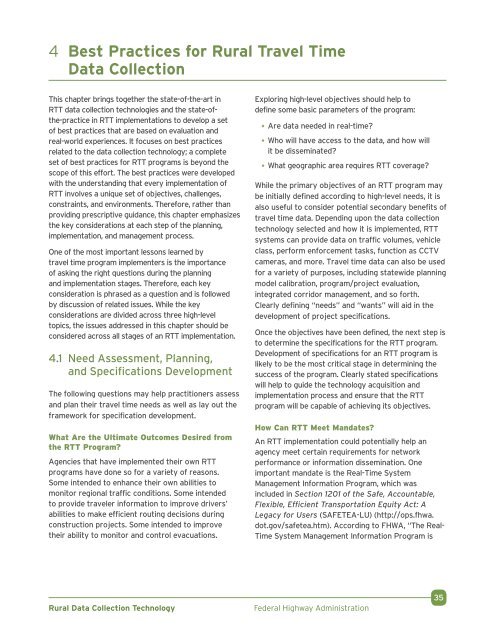Rural Data Collection Technology - FHWA Operations - U.S. ...
Rural Data Collection Technology - FHWA Operations - U.S. ...
Rural Data Collection Technology - FHWA Operations - U.S. ...
- No tags were found...
You also want an ePaper? Increase the reach of your titles
YUMPU automatically turns print PDFs into web optimized ePapers that Google loves.
4 Best Practices for <strong>Rural</strong> Travel Time<strong>Data</strong> <strong>Collection</strong>This chapter brings together the state-of-the-art inRTT data collection technologies and the state-ofthe-practicein RTT implementations to develop a setof best practices that are based on evaluation andreal-world experiences. It focuses on best practicesrelated to the data collection technology; a completeset of best practices for RTT programs is beyond thescope of this effort. The best practices were developedwith the understanding that every implementation ofRTT involves a unique set of objectives, challenges,constraints, and environments. Therefore, rather thanproviding prescriptive guidance, this chapter emphasizesthe key considerations at each step of the planning,implementation, and management process.One of the most important lessons learned bytravel time program implementers is the importanceof asking the right questions during the planningand implementation stages. Therefore, each keyconsideration is phrased as a question and is followedby discussion of related issues. While the keyconsiderations are divided across three high-leveltopics, the issues addressed in this chapter should beconsidered across all stages of an RTT implementation.4.1 Need Assessment, Planning,and Specifications DevelopmentThe following questions may help practitioners assessand plan their travel time needs as well as lay out theframework for specification development.What Are the Ultimate Outcomes Desired fromthe RTT Program?Agencies that have implemented their own RTTprograms have done so for a variety of reasons. .Some intended to enhance their own abilities tomonitor regional traffic conditions. Some intendedto provide traveler information to improve drivers’abilities to make efficient routing decisions duringconstruction projects. Some intended to improvetheir ability to monitor and control evacuations.Exploring high-level objectives should help todefine some basic parameters of the program:• Are data needed in real-time?• Who will have access to the data, and how willit be disseminated?• What geographic area requires RTT coverage?While the primary objectives of an RTT program maybe initially defined according to high-level needs, it isalso useful to consider potential secondary benefits oftravel time data. Depending upon the data collectiontechnology selected and how it is implemented, RTTsystems can provide data on traffic volumes, vehicleclass, perform enforcement tasks, function as CCTVcameras, and more. Travel time data can also be usedfor a variety of purposes, including statewide planningmodel calibration, program/project evaluation,integrated corridor management, and so forth.Clearly defining “needs” and “wants” will aid in thedevelopment of project specifications.Once the objectives have been defined, the next step isto determine the specifications for the RTT program.Development of specifications for an RTT program islikely to be the most critical stage in determining thesuccess of the program. Clearly stated specificationswill help to guide the technology acquisition andimplementation process and ensure that the RTTprogram will be capable of achieving its objectives.How Can RTT Meet Mandates?An RTT implementation could potentially help anagency meet certain requirements for networkperformance or information dissemination. Oneimportant mandate is the Real-Time SystemManagement Information Program, which wasincluded in Section 1201 of the Safe, Accountable,Flexible, Efficient Transportation Equity Act: ALegacy for Users (SAFETEA-LU) (http://ops.fhwa.dot.gov/safetea.htm). According to <strong>FHWA</strong>, “The Real-Time System Management Information Program is<strong>Rural</strong> <strong>Data</strong> <strong>Collection</strong> <strong>Technology</strong>Federal Highway Administration35
















